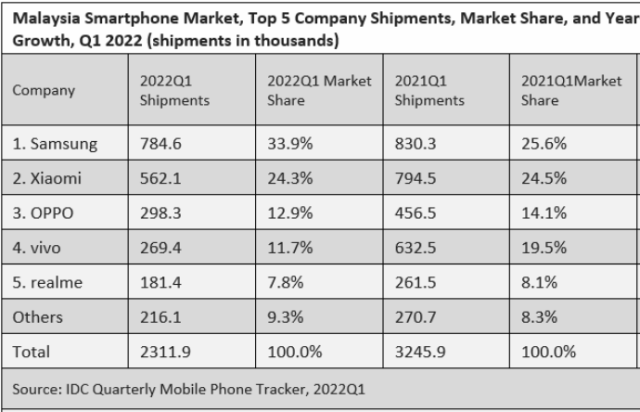Smartphone shipments in Malaysia fell 28.8 percent year-on-year and dropped 21.7 percent quarter-over-quarter in the first quarter of 2022, according to data from IDC report.

The drop in smartphone shipments in Malaysia was due to supply challenges for low-end 4G smartphone models, especially from the Chinese vendors, impacting volumes and allocations. The cost of living climbed in Malaysia since the start of 2022, hitting essential goods and other baskets, lowering consumers’ budget for smartphones.
IDC projects a decline of 5 percent for the Malaysia smartphone market in 2022. Supply constraints for Android’s 4G low-end models will make it a challenge for most vendors to meet the demand. The poor demand will lower shipments of higher-priced models.
5G in Malaysia hit another roadblock in mid-May as the top providers are negotiating with the Digital Nasional Berhad (DNB).
“Phone brands are not optimistic that 2022 will see a high adoption rate for 5G plans by consumers. Confidence in the coverage quality and the rollout speed will be a major hurdle, along with data plan costs, but we expect the smartphone vendors to continue to roll out 5G smartphones in the market,” said Ahmed M. Ahmed, Mobile Devices Market Analyst at IDC Malaysia.
Top 5 smartphone vendors in Malaysia
Samsung’s smartphone share in Malaysia declined by 5 percent QoQ in 1Q22 despite demand for the new Galaxy S22 smartphones. Rising costs hit the new Galaxy A series, and 2022 refreshes came at a higher price compared to last year. Samsung was the leader in the 4G space with nearly 38 percent share of that segment.
Xiaomi was the only Top 5 brand to record a QoQ growth, recording just shy of a 5 percent increase in 1Q22. Xiaomi faced some supply tightness in March going into April and the Chinese phone brand didn’t ship any models within the sub-US$100 segment. The new Redmi Note 11 Pro was its top model in the mid-range and its aggressive retail expansion continued.
OPPO came in third place despite declining both YoY and QoQ. Shipments of 4G smartphone models for OPPO’s A series were impacted due to supply issues. OPPO offered price cuts and bundles to improve the sluggish sales of the mid-range. OPPO’s effort to break into the premium space continued with more concept stores to offer a better user experience.
Vivo was also impacted by the lower allocation of 4G smartphone models to Malaysia. In 1Q22, Vivo came in fourth place with a YoY decline of over 57 percent. Vivo’s online shipments stayed consistent despite the lifting of restrictions and the rise of retail shopping.
Realme returned to the Top 5 smartphone list in Malaysia. While Realme slipped by nearly 31 percent QoQ, it managed to increase its market share to 7.4 percent, up by 1.4 percentage points. Realme has stayed strong in the low-end segment where demand was soaring with the C series, using Unisoc chipsets for its entry-level smartphone models.





